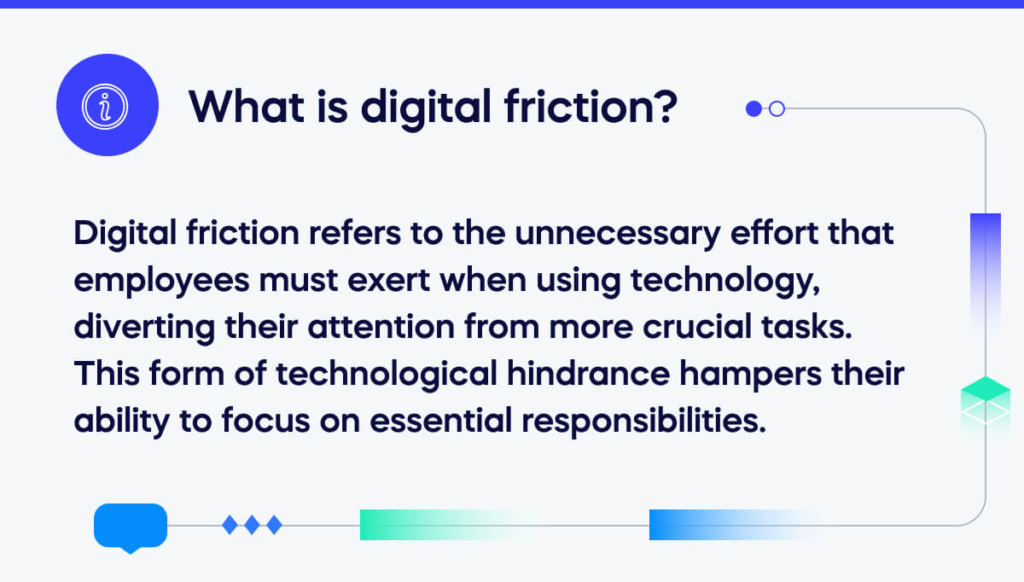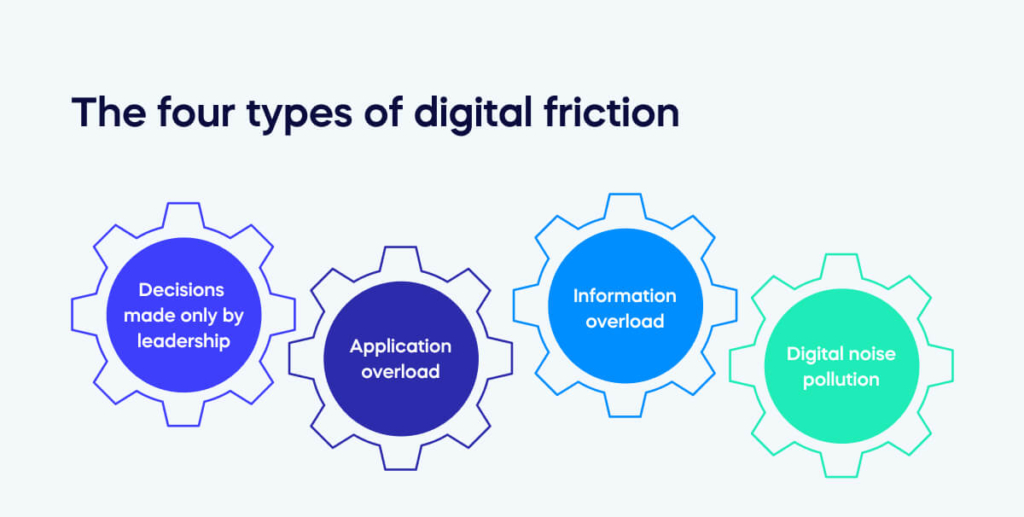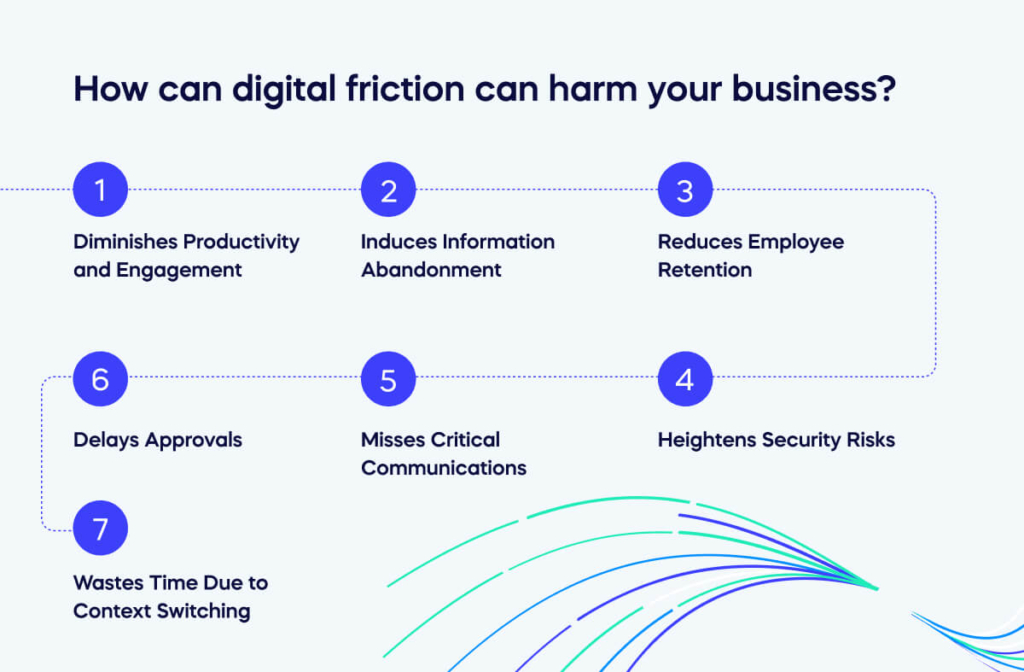What Is Digital Friction?
Digital friction refers to the unnecessary effort that employees must exert when using technology, diverting their attention from more crucial tasks. This form of technological hindrance hampers their ability to focus on essential responsibilities.

Table of contents
Alongside customer experience, the focus on employee experience has notably risen in business.
With the growing emphasis on enhancing the employee experience, attention has pivoted towards the digital employee experience, centering on equipping employees with the necessary digital tools and support to optimize their performance in the modern workplace.
However, many organizations fall short in this area. Despite a consistent surge in investments in workplace technologies, employees still feel that businesses need to do better to improve digital adoption.

Digital Friction Misconceptions
Studies suggest that 95% of employees encounter digital workplace friction, exemplified by issues with software, networks, accessibility of workplace applications, and sluggish devices.
As a result, several misconceptions regarding digital friction persist, including:
Only affects experience
There is a common misconception that digital friction solely influences the experience.
While it undeniably plays a pivotal role in shaping user experience, its implications extend beyond, affecting various business aspects such as productivity, recruitment expenditures, and the potential attrition of talented employees.
Industry-specific issues
While digital friction, the resistance experienced in industries heavily reliant on technology, is a well-known phenomenon, it is important to note that it is not limited to these sectors alone.
Businesses, irrespective of their size or industry, can be impacted by the effects of digital friction.
This can manifest in various ways, such as inefficiencies in processes, difficulties in adapting to technological advancements, or challenges in maintaining effective communication channels.
Recognizing and addressing digital friction is crucial for organizations to thrive in today’s interconnected world.
Technical user problem
Another misconception is that digital friction is solely an issue for individuals with technical backgrounds.
It can pose challenges for anyone interacting with digital products or services, irrespective of their technological proficiency.
What are the most popular sources of digital friction in the workplace?
Conflict is unavoidable in today’s diverse workforce, comprised of various backgrounds, perspectives, personalities, and worldviews.
Nevertheless, recognizing the most prevalent sources of digital friction is crucial. Here are several potential contributors:
Decisions made only by leadership
Leaders can make technology-related decisions without fully grasping the implications of daily operations. Additionally, there is a lack of consideration of an employee’s interests in technology investments.
Application overload
When an organization introduces an overwhelming number of applications for employees to use without effectively managing the rollout user adoption process or providing sufficient training and support, it creates a situation of digital friction.
This digital friction can manifest as confusion, frustration, and inefficiency among employees, hindering their ability to fully embrace and leverage the potential of these applications.
It is crucial for organizations to carefully plan and execute the implementation of new applications, ensuring seamless integration, comprehensive training, and ongoing support to maximize productivity and minimize the negative impact of digital friction.
Information overload
The sheer number of apps, content, conversations, tasks, and information that employees have to locate due to a mismanaged technology rollout creates data silos and redundancy and leads to significant inefficiencies and reduced productivity.
This wastes valuable time and resources on repetitive tasks, impeding collaboration and hindering overall organizational effectiveness.
Digital noise pollution
The constant barrage of notifications, signals, and alerts strains an employee’s finite attention span, and information processing capacities can overwhelm employees. This deluge of information often leads to increased stress, impaired decision-making, and diminished performance.

How can digital friction can harm your business?
Digital friction harms businesses by reducing productivity, causing a poor user experience, and negatively affecting morale.
Failing to address digital friction can drive away customers and harm a company’s bottom line.
Here’s how digital friction can detrimentally impact your workplace transformation:
- Diminishes Productivity and Engagement: Digital friction leads to hindrances in task completion, fostering frustration and extended completion times among employees. This scenario decreases efficiency, adversely impacting overall productivity and engagement levels.
- Induces Information Abandonment: The persistent struggle to locate necessary information from various technology sources can cause frustration and lead to abandonment of processes by employees, resulting in missed opportunities and elevated costs.
- Reduces Employee Retention: Bad experiences with technology used can tarnish a company’s reputation and impede its ability to retain talent.
- Heightens Security Risks: Digital friction complicates safeguarding digital products or services, elevating the risk of data breaches and other security incidents.
- Misses Critical Communications: Employees are at risk of overlooking essential announcements and time-sensitive reminders amidst the digital noise.
- Delays Approvals: Important work or requests might be stalled as managers overlook approvals amid a deluge of emails.
- Wastes Time Due to Context Switching: Employees must alternate between various technological systems to complete tasks or retrieve information, losing valuable time.

How can you reduce digital friction in the workplace?
Implementing a range of strategies can minimize the adverse effects of digital friction in the workplace and improve your chances of a successful digital transformation.
Reduce the number of tools and technologies utilized
The excessive use of tools can disrupt employees’ workflow, as constantly switching between them leaves little time for actual work.
Therefore, it is essential to avoid overwhelming employees with excessive tools and optimize them and the IT systems for efficiency.
Instead, reduce digital friction by reviewing all your employees’ current tools to see if any waste time, cause frustration, or do not result in productivity.
Make it easier for employees to grasp new technology
Training and education are crucial in enhancing employee productivity and reducing digital friction.
Before adopting new technology, your company’s leaders can hold information sessions with workers detailing the reasoning behind technology adoption and resolve issues early on in the process.
This action allows employees to collaborate with leaders to adopt new technologies, eliminating pain points.
Then, during the technology implementation process, businesses should supply employees with the necessary skills and knowledge to enable them to adopt digital technology more effectively and efficiently.
Following this, team leaders can also hold feedback sessions that allow employees to give their opinions on the benefits and disadvantages of a tool so that methods of minimizing digital friction are discussed and the employee experience is always kept at the forefront.
Empower employees to learn more independently
Offering self-service options, such as an internal knowledge base, can significantly assist employees in finding the information they require and completing tasks independently.
This digital solution can also increase productivity and reduce employees’ reliance on others for support.
Continue to modernize legacy systems continually
Evaluating how existing technology may perpetuate ongoing issues should also be part of an ongoing digital adoption strategy.
Questions you need to ask include:
- when the digital landscape was last reviewed
- what technologies are currently being utilized
- when certain technologies should be used
- how much technical debt has accumulated in recent years
How can DAPs reduce digital friction?
Organizations can reduce digital friction by streamlining processes and ensuring consistent workflows. Furthermore, they can enhance the user-friendliness of digital technologies and eliminate barriers to their utilization to the greatest extent possible.
In a world characterized by a wide range of software-based tools and platforms, maintaining a consistent user experience is of utmost importance.
Digital adoption platforms (DAPs) guarantee that users encounter a uniform experience across various platforms, thereby mitigating confusion and enhancing user satisfaction.
This consistency contributes to a seamless workflow and empowers users to troubleshoot issues immediately, eliminating the need for prolonged troubleshooting sessions with the support team or unnecessary support tickets.
A digital adoption platform’s advantages include efficient user onboarding, elevated user proficiency, increased productivity, improved user satisfaction, data-driven decision-making, and an engaging learning experience. To minimize the adverse effects of digital friction in the workplace and improve your chances of a successful digital transformation, it is possible to implement a range of strategies, including leveraging DAPs for real-time assistance and performance support, leading to swift resolution of obstacles and boosting overall efficiency.